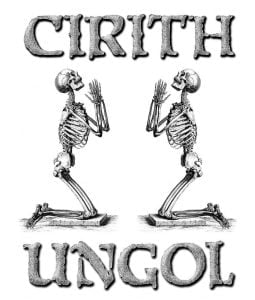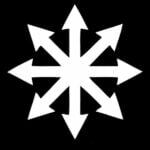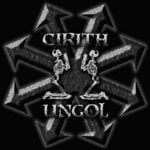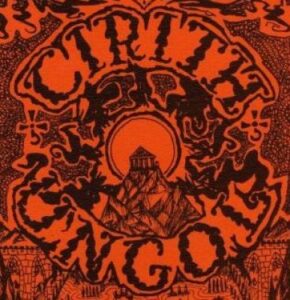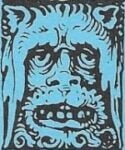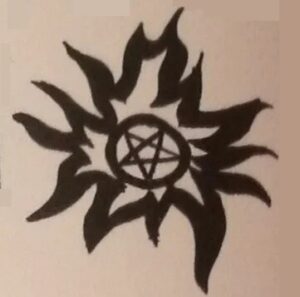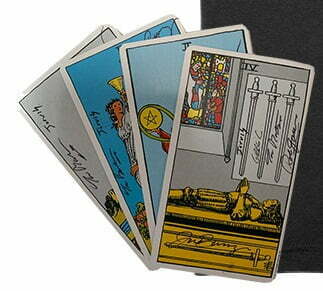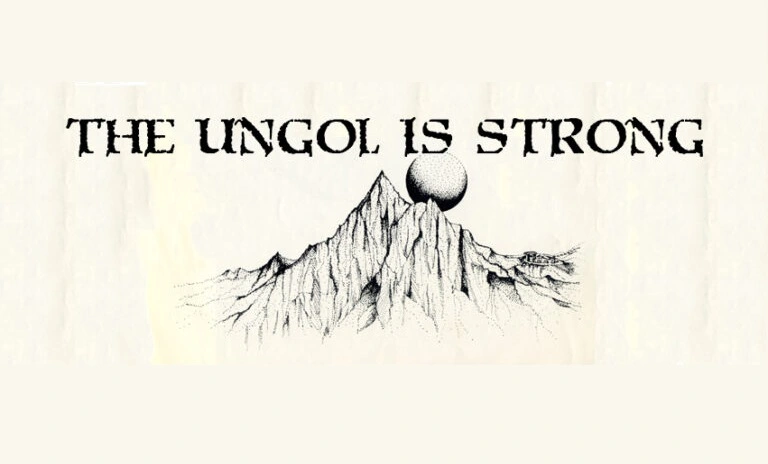- 🔙 Back to Misc
- | Ferrari »
- ⚠️ Add, Edit or Remove your item
- 🗺️ Old Cirith Ungol Webpit
- 🔍 Logos (DuckDuckGo search or Google search or WP search or FB)
Osteographia, or The anatomy of the bones
William Cheselden (19 Oct 1688 – 10 Apr 1752) is author on a book. This image is called plate 36 (XXXVI).
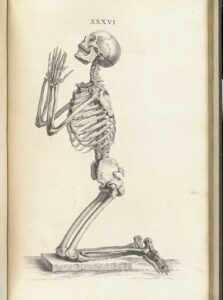
See the further here on this site.
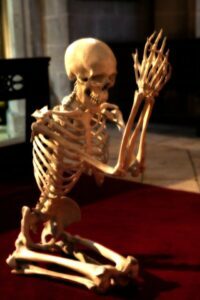
Skeleton (Patrick)
Praying Skeleton logo
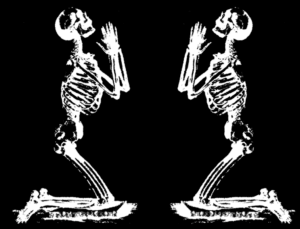
The praying skeleton logo is our own design, dating back to around 1977.
– Greg Lindstrom
Draft logo
New logo I created. I spent hours trying to replicate the amazing etching detail of William Cheselden for the typeface and trying to replicate the contours of the bones! Let me know what you think!
I recently found a super high resolution version of the original skeleton and wanted to create an updated logo, not sure if anyone in the band or fans would accept it. I have to be honest his original etching had to do some skeletal gyrations to get them bones to match the same angle and pose of the one we adopted so many years ago. Thanks to modern technology this was possible although a modern Yogi would have been impressed. I am most proud of the work I did on the lettering with the texture, shaping, and spacing of each letter.
Of course this was just an exercise in creativity and I thought I would run it up the flagpole to see if anyone would salute it! I guess this is the ultimate tattoo challenge!
Many don’t know the true history of how our logo came about. Greg‘s family ran a print shop at one time and found the clip art of William Cheselden‘s famous praying skeleton, about the time the band was getting started. We liked the look, copied and flipped one around. I found a type face that I had been using called Stonehenge (at the time) to create our name, and our logo was born. The history of William Cheselden’s book was similar to our first album, when it first came out it wasn’t financially successful and much of his etchings became copyright free over the years. That is why you’ll see them in various locations, although our logo was one of the first to use some commercially. (Twitter, 13 Feb 2021)
Eternal Flames: Who drew the praying skeletons?
They were something Greg came up with. We liked them and they stayed as our logo
– Robert Garven
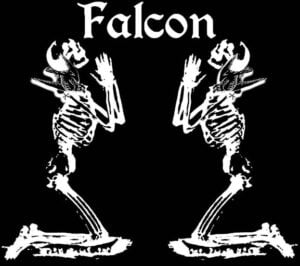
This is the most common logo since 2003. It has been adapted by Falcon.
Dig the cool reverse “Cirith Falcon” logo!
Perry Grayson, 09 Nov 2003
See also Similar to Praying Skeleton.
Chaos Star, Wheel of Fate, Symbol of Chaos
- Chaos Star / Praying Skeleton / Stonehenge
Next to the praying skeletons CU use the symbol of the chaos star. What’s behind that? Can you tell us anything about this symbol? Nowhere at all we found any information about the sign of the chaos star … (Other bands we found using the sign of the chaos stars on their LPs/logos etc. are Bolt Thrower and Sepultura…)
Eternal Flame
In the Moorcock books the CHAOS sign is described as a symbol with many arrows pointing in all directions symbolizing the many possibilities of CHAOS! The symbol of LAW was one arrow pointing up. We liked the idea of CHAOS and I designed the logo based on my readings of the book.
Robert Garven
We had a gigantic praying skeleton logo backdrop and sometimes the glowing Wheel of Fate logo off our album.
Robert Garven
Wheel of Fate logo and Chaos Star, is the same or different? Here is Symbol of Chaos.
See also Similar to Chaos Star.
Cirith Ungol
They took their name from the place Cirith Ungol in J. R. R. Tolkien’s epic fantasy novel The Lord of the Rings. The name Cirith Ungol is Elvish and means “Pass of the Spider”.
The “Cirith Ungol” is name of three alternatives:
- Cirith Ungol, the Elvish and means “Pass of the Spider”.
- Cirith Ungol, the Metal band.
- Cirith Ungol, the Metal song.
See the further song with Cirith Ungol and J.R.R. Tolkien.
Typeface (font)
The typeface Quadrata II by Paul Hayden Duensing (1929-2006). He was typographer, type designer, cut and cast for his Private Press and Type foundry. Typeface Quadrata II (*) is somewhere between 1970 to 1974.
The typeface is Stonehenge by Albie Fiore (1946-2009) published by Graphic Products Corporation, seen on Citadel Miniatures (founded 1978/9), subsidiaries of Games Workshop (founded 1975). It has also the Chaos Star and related to the The Lord of the Rings books/movies. Adopted by Formatt for dry-transfer lettering and shown in their 1974 catalog as Stonehenge.
Original Logo
The picture is part of one of the flyers that had the original Cirith Ungol logo. The original CU logo was designed by Rob Garven, who was a graphic illustrator.
One Foot In Hell and Paradise Lost has the typeface on DAW Books. Probably Charleston or Radius FG.
Pictogram
Or paintings, emotions, emoji, ideogram, Necronomicon, etc. What is the originally source? And who is the illustrator?
- Also of the cover Demon Flight (1982)
- Also of the cover Demon Flight (1982)
- Also of the cover Demon Flight (1982)
- Also of the cover Demon Flight (1982)
- Also of the cover Demon Flight (1982)
- Also of the cover Demon Flight (1982)
- Also of the cover Hootch (1974)
- Also of the cover of Rex Bruce
- Also used by “Tattoo You (Temporarily!)”
- None CU: “Tattoo you (Temporarily!) Dynamite paint-ons stay for days or remove instantly! Great gift/party kit $20 postpaid from TEMPTU, 1225 Broadway, New York, NY 10011.” @ Creem
- Also of the cover Demon Flight (1982)
- Also of the cover Demon Flight (1982)
- Also of the cover Demon Flight (1982)
- Also of the cover Demon Flight (1982)
- Also of the cover Demon Flight (1982)
- Book is Poeti Umanisti Maggiori. Possibly the original source.
- Book is Poeti Umanisti Maggiori
- Rush opened for Hawkwind, Kansas City, KC on 18 Oct 1974. Down and left side, which logos or ideogram they have used? .
Hook and Cross
See
Pentagram
The inverted pentagram ⛧ is used on at least for poster on the gig:
Tarot
Tarot Card.
Garven: Halvar [The Planet Of Doom], he’s the protagonist guy in the movie. He’s kind of like a viking biker guy that travels through time to go back to kill the guy that murdered his wife. I can’t pronounce the monster’s name or whatever but anyway his name was Halvar. That’s the guy. So in our part of the thing he gets to like a cave and he goes in there meeting a witch. She reads his tarot cards, and while reading the tarot…
Baker: All you need to do is read the lyrics to “Witch’s Game.”
Garven: But yeah, he goes inside… I’m just telling you, that he goes inside each tarot card and he fights the monster.
Summary
Original artist | The band Cirith Ungol | Other bands |
Cover painting (Frank Frazetta) | First cover: "At the time we wanted a “Sword and Sorcery” theme cover called “Berserker” by Frank Frazetta, a famous sword and sorcery artist, but it was taken by the country rock band MOLLY HATCHET!" - Rob Second cover: v/a - Frazetta compilation album, with amongst Cirith Ungol (Picture disc, 2016) | Dust, Nazareth, Molly Hatchet, Yngwie Malmsteen, etc. |
Cover painting - Elric (Michael Whelan) | Painting (year)
| Same cover painting, but different font: Elric – Stormbringer, Antihero, Elric of Melnibon (all from 2017) |
Authors and his band also (Michael Moorcock) | DAW Books (year) The Elric Saga 2. The Sailor on the Seas of Fate (Dec 1976) Paradise Lost (1991)
The Elric Saga 4. The Vanishing Tower (Jun 1977) The Elric Saga 5. The Bane of the Black Sword (Oct 1977) King of the Dead (1984) The Elric Saga 6. Stormbringer (Nov 1977) | His own band: Michael Moorcock & The Deep Fix |
Chaos Star (Michael Moorcock) | Cirith Ungol | The Lamp of Thoth, Eternal Champion, Helstar, Bolt Thrower, Attila, Slave Lunacy, Agent Steel, |
Cover painting - others (Michael Whelan) | Witch’s Game (2018) | Sepultura, Meat Loaf, Obituary, Demolition Hammer, The Mist, Smoulder, Sacred Rite, Renegade, etc |
Hook and Cross (Bill Gawlik) | Cirith Ungol | |
The Lord of the Rings (J.R.R. Tolkien) | The band and the song: Cirith Ungol | Burzum, Gorgoroth, Morgoth, Amon Amarth, Isengard, etc |
Praying Skeleton (William Cheselden - Osteographia) | Cirith Ungol | Black Oath, Minimum Syndicat, Archaeaeon, Prophets of Rage, Avenged Sevenfold, etc |
Necronomicon (H. P. Lovecraft) | Cirith Ungol (they have it at least 1978-86) | Necronomicon (all of the bands) |
Stonehenge | Cirith Ungol | Artch - Another Return |
Pyramid, castle and mountain
See Pyramid, castle and mountain.
